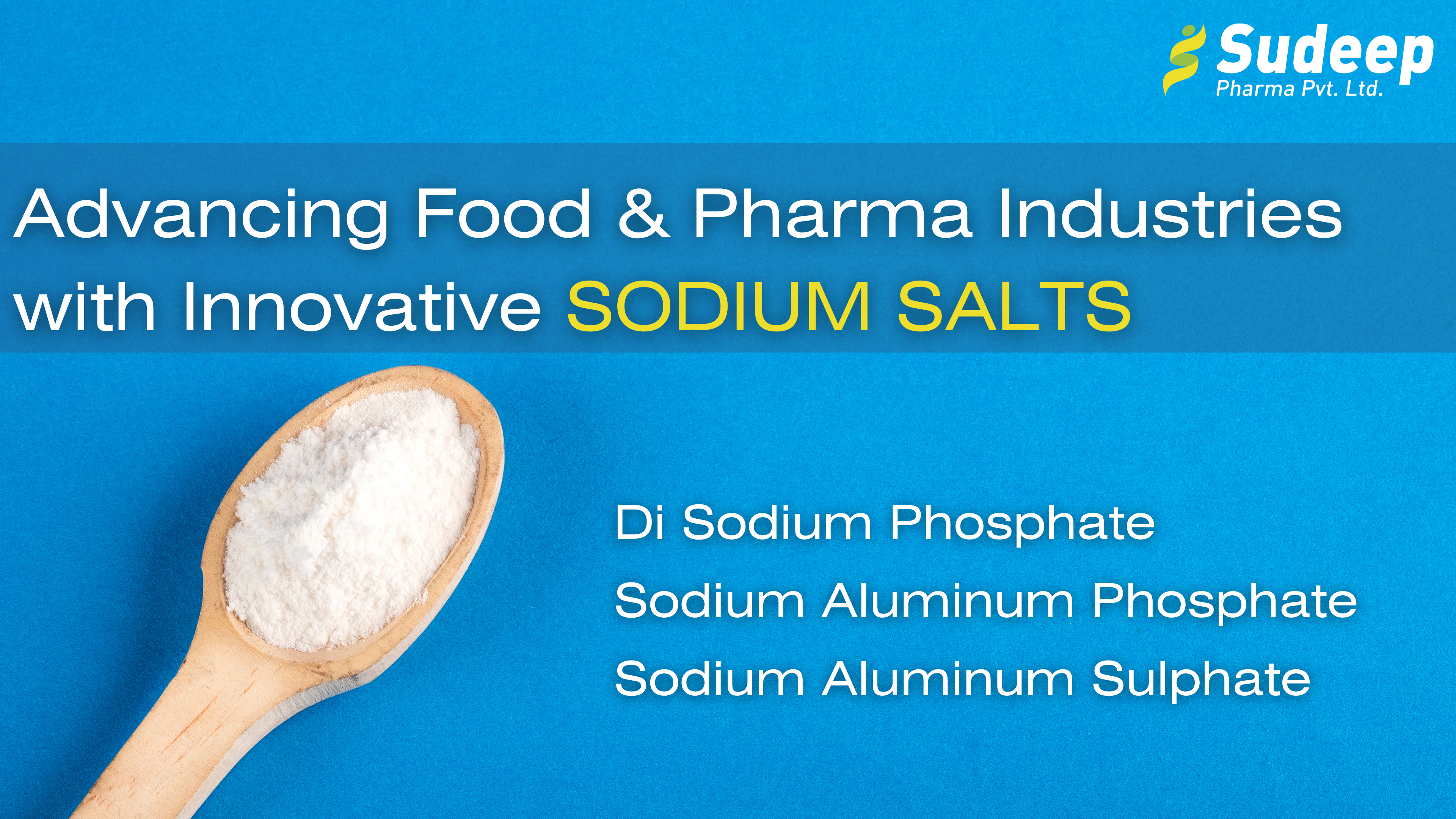In the realm of food and pharmaceutical industries, the demand for high-quality ingredients that enhance product performance while maintaining safety standards is ever-increasing. Sudeep Pharma, a pioneering manufacturer, is at the forefront of meeting this demand with its range of cutting-edge sodium salts, including Di Sodium Phosphate, Sodium Aluminum Phosphate, and Sodium Aluminum Sulphate.

In this article, we delve into the technical aspects, benefits, and versatile applications of these salts.
Technical Overview:
1. Di Sodium Phosphate (DSP): Di Sodium Phosphate, a sodium salt derived from phosphoric acid, is a vital ingredient in various food and pharmaceutical formulations. Its chemical formula, Na2HPO4, reflects its composition of two sodium ions and one phosphate ion.
2. Sodium Aluminum Phosphate (SALP): Sodium Aluminum Phosphate, denoted as NaAl3(PO4)2(OH)6, is an aluminium-based compound often used as a leavening agent in baked goods. Its unique structure provides the desired leavening effect and texture enhancement.
3. Sodium Aluminum Sulphate: Sodium Aluminum Sulphate, represented as NaAl(SO4)2, boasts versatile applications in both food and pharmaceutical industries. Its chemical properties make it a proficient acidity regulator and texturizer.
Applications in Food and Pharma Industries:
A. Food Industry:
i. Di Sodium Phosphate (DSP): Dibasic Sodium Phosphate (DSP), also known as disodium phosphate, is a chemical compound that has various applications in the food industry. It is commonly used as a food additive and pH buffer due to its ability to regulate acidity and improve texture in a variety of food products. Here are some of its applications in the food industry:
1. Emulsification and Texturization: DSP is often used to improve the texture and mouthfeel of processed foods. It can act as an emulsifying agent, helping to stabilize oil and water mixtures in products like processed cheeses, puddings, and whipped toppings.
2. pH Buffer: DSP is a pH buffer, meaning it can help maintain a stable pH level in food products. It is used to control the acidity and alkalinity of various food items, including canned vegetables, processed meats, and beverages. This helps enhance the flavor and overall quality of the products.
3. Baking Powder: In baking, DSP can be included in baking powder formulations to regulate the reaction between the acid and the base components. This ensures proper leavening and rising of baked goods, such as cakes, muffins, and pancakes.
4. Processed Meats: DSP is used in processed meats like sausages and deli meats to improve their texture, extend shelf life, and enhance water retention. It can also contribute to the development of a desirable pink color in some cured meats.
5. Cheese Processing: DSP is added to processed cheese products to improve their meltability, consistency, and texture. It helps prevent the separation of fat and water in cheese products, giving them a smooth and uniform texture.
6. Canned Vegetables: When canning vegetables, DSP is sometimes added to help preserve their color and texture by controlling the pH of the canned product.
7. Beverages: DSP is used in some beverage formulations as a pH buffer and to enhance the stability of certain compounds. It can also be used to prevent the precipitation of minerals in bottled beverages.
8. Nutritional Supplements: DSP is sometimes added to nutritional supplements and meal replacement products to provide a source of phosphorus, an essential nutrient for the body.
ii. Sodium Aluminum Phosphate (SALP): Sodium Aluminum Phosphate (SALP) is a chemical compound that is commonly used in the food industry as a leavening agent. Leavening agents are substances that are added to baked goods to help them rise and become light and airy. SALP is particularly used in baking powder formulations to provide the necessary carbon dioxide gas that causes dough and batter to expand during baking. Here’s how SALP is applied in food:
1. Baking Powder: SALP is often included as a component of baking powder. Baking powder is a mixture of an acid, a base, and a filler (usually starch). When baking powder is mixed with liquid and exposed to heat, the acid and base react with each other, producing carbon dioxide gas. This gas gets trapped in the dough or batter, causing it to rise. SALP serves as one of the acid components in baking powder formulations.
2. Leavened Baked Goods: SALP is used in a variety of leavened baked goods such as cakes, muffins, pancakes, biscuits, and quick breads. These products rely on the expansion of the batter or dough to create a light and fluffy texture.
3. Functionality: SALP works by releasing carbon dioxide gas when it reacts with an alkaline ingredient in the batter or dough, such as baking soda (sodium bicarbonate). The carbon dioxide gas forms bubbles that become trapped in the mixture, causing it to rise. As the product bakes, the gas expands further, giving the baked goods their characteristic texture.
4. pH Adjustment: In addition to its leavening properties, SALP can also help adjust the pH of the batter or dough. Proper pH is important for the chemical reactions that occur during baking, as well as for the overall flavor and texture of the finished product.
iii. Sodium Aluminum Sulfate: Sodium Aluminum Sulfate, also known as sodium aluminium sulphate or sodium alum, is a chemical compound with the formula NaAl(SO4)2. It is often used as a food additive and has various applications in the food industry. Here are some of its common uses and applications:
1. Leavening Agent: Sodium Aluminum Sulfate is used as a leavening agent in baking powders. It reacts with the baking soda (sodium bicarbonate) in the mixture to release carbon dioxide gas, which helps baked goods rise and become fluffy.
2. Acidity Regulator: It can act as an acidity regulator or buffer, helping to control and maintain the pH level of certain foods and beverages. This is important for ensuring proper flavor, texture, and shelf life.
3. Stabilizer: Sodium Aluminum Sulfate can be used as a stabilizer in products like whipped cream and meringue. It helps improve the stability and texture of these products by strengthening the protein matrix.
4. Water Treatment: In some cases, it’s used for water purification or water treatment in food processing to remove impurities or unwanted particles from water used in food production.
5. Gelling Agent: It can aid in the gelling process for certain foods, such as pickles and gelatin desserts.
6. Dye Fixative: Sodium Aluminum Sulfate can be used as a dye fixative in certain food colouring processes to help the colour adhere to the food more effectively.
B. Pharma Industry:
Sudeep Pharma’s sodium salts also find applications in the pharmaceutical sector:
Di-Sodium Phosphate, Sodium Aluminum Phosphate, and Sodium Aluminum Sulfate are all chemical compounds that have various applications in the pharmaceutical industry. They are commonly used as excipients or additives in pharmaceutical formulations to achieve specific functions. Here’s how each compound is used:
1. Di-Sodium Phosphate (DSP):
· Function: Di-Sodium Phosphate, also known as disodium hydrogen phosphate, is used as a buffering agent, pH adjuster, and emulsifying agent in pharmaceutical formulations.
· Application: It is often used in oral medications and injections to control the pH of solutions, ensuring stability and compatibility with other ingredients. It can also be used to adjust the pH of certain oral medications to make them more tolerable for patients.
2. Sodium Aluminum Phosphate (SALP):
· Function: Sodium Aluminum Phosphate is used as a leavening agent, buffer, and stabilizer in pharmaceuticals.
· Application: In pharmaceuticals, SALP is commonly used in the formulation of effervescent tablets. Effervescent tablets release carbon dioxide when dissolved in water, which can help improve the solubility and absorption of certain drugs. SALP contributes to the effervescence and stability of these tablets.
3. Sodium Aluminum Sulfate:
· Function: Sodium Aluminum Sulfate, also known as sodium alum or sodium aluminium sulphate, is primarily used as a leavening agent and firming agent in pharmaceuticals.
· Application: Similar to SALP, Sodium Aluminum Sulfate is used in the formulation of effervescent tablets to provide the effervescence and help with the disintegration of the tablets in water. It can also be used to improve the texture and shelf life of certain solid dosage forms.
It’s important to note that the use of these compounds in pharmaceuticals is subject to strict regulations and guidelines to ensure their safety and efficacy. Additionally, the specific applications and concentrations of these compounds can vary based on the intended use and formulation requirements of the pharmaceutical product.
In conclusion, Sudeep Pharma’s portfolio of sodium salts, including Di Sodium Phosphate, Sodium Aluminum Phosphate, and Sodium Aluminum Sulphate, represent a cornerstone of innovation in the food and pharmaceutical industries. These salts offer a diverse range of technical benefits, ensuring the quality, functionality, and regulatory compliance of products. From enhancing texture and flavor in baked goods to stabilizing pH in pharmaceutical formulations, Sudeep Pharma’s sodium salts continue to drive advancements that shape the future of these industries.


Add a Comment